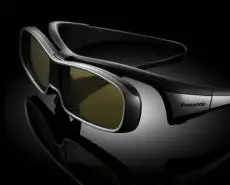 CES 2010 went back to the future, much like the movie business these days. A gimmick from the 1950s has become the great hope for saving Hollywood from fiscal crisis (as for the ongoing creative crisis in Hollywood, no solution’s yet been found), and now the consumer electronics industry has given 3D presentations their bonafides by showcasing virtually nothing but HDTVs, Blu-ray players, a few computer displays and other gizmos geared toward providing consumers with the ultimate immersive experience from their living room sofas. In the quest for bigger, better, bolder— as well as smaller, superior and sleeker— the hottest hi-def products at CES will soon influence the home theater experience. But, with 3D enabled devices already trickling into the marketplace, is the time right to invest in this newest technology?
CES 2010 went back to the future, much like the movie business these days. A gimmick from the 1950s has become the great hope for saving Hollywood from fiscal crisis (as for the ongoing creative crisis in Hollywood, no solution’s yet been found), and now the consumer electronics industry has given 3D presentations their bonafides by showcasing virtually nothing but HDTVs, Blu-ray players, a few computer displays and other gizmos geared toward providing consumers with the ultimate immersive experience from their living room sofas. In the quest for bigger, better, bolder— as well as smaller, superior and sleeker— the hottest hi-def products at CES will soon influence the home theater experience. But, with 3D enabled devices already trickling into the marketplace, is the time right to invest in this newest technology?
First, a short lesson. The well-known technology life-cycle in the marketplace predicts that products go through phases or segments of marketing focus and consumer interest. First, new products fresh out of R&D gain the notice of the innovators: early adopters who purchase products well before they become financially feasible for most of us to buy. Marketers love them because they’re going to get the word-of-mouth going about new products. They are patient zero, ready to spread the viral news of the nifty gizmo through regular human interaction. No matter the cost or practical application, early adopters feel the need to be at the forefront of change and cutting-edge breakthroughs regardless of whether those products even work properly. The promise of technology at this point often exceeds its practical ability to perform with consistency and dependability, and the initial high cost for new technology is usually a major disqualifying factor for the average mainstream consumer. Add to that the hardware/software relationship (content that may not be available for hardware new to the marketplace) and the potential for purchase becomes a bit more prohibitive to the average consumer. It’s a make-or-break period for products at that stage, and those that survive due to ongoing consumer interest (for whatever reason) become the hyped products that will fall into the hands of early majority and late majority buyers, as they’re they next ones in the tech product life-cycle.
Then, there’s the good ol’ laggards… those who just give in, or feel the need to finally be part of the crowd. It’s the last stop on the consumer electronics bandwagon, though a carefully branded and marketed product lifespan can continue on long after that. It is the pragmatic approach of these last groups, the majority and laggards, that call into question whether three-dee will take off with Joe the Average Television Viewer. If the tech product life-cycle is correct, Joe will sit things out until it becomes clear, usually by force, that the future is now. I say force because the only way the average consumer will part with a dollar for something that’s not quite a deal yet is to be forced by the invisible hand of capitalism or, in the case of all those new flat-screened HDTVs sold over the last year-and-a-half (that Joe TV Viewer just bought), government edict. Just remember that for HDTV to take off in the marketplace the government basically made it impossible for your old analog television set to get reception by changing broadcast standards nationwide and selling the old bandwidth for other use. Sure, that’s progress… but it also means consumer choice isn’t necessarily considered sacrosanct. This may or may not happen with 3DHD, but without some type of force, it is doubtful that Jane n’ Joe TV Viewer will plop down another several hundred bucks (having just bought an HDTV set within the last year or so) for a 3D capable device that lacks content and still needs a heckuva lot of technological tweaking. After all, CES is hardly a barometer of how golly-gee-neato gizmos work in the real world and perform in the marketplace. [more after the break]
With all that said, the time isn’t quite right to jump into the 3D phenomenon just yet, though you’ll certainly know a propeller-head or two that cannot wait to get into 3D gaming, or movies or whatnot simply because, as the guy that climbed Everest said, it’s there. And bravo to them for making that great leap into the unknown (and parting with a considerable amount of cash). That’s what risk-taking is all about whether you’re an institutional investor or a software beta-tester, someone has gotta do it first.
But the question remains… Is this the right time to invest in such technology. Again, I’d say probably not… for a few reasons. The primary one, and let’s just stare down that 800-pound Na’vi right away, is that the mostly orgasmic response to Jim Cameron’s “game-changer” will eventually fade away leaving only millions if not billions in cash behind as well as a host of good intentions for not-so-great ideas. Just because a smattering of tech-driven directors (JacksonBerg I’m looking at you!) feels the need to hop on the bandwagon, don’t expect that over the next few years, even possibly the next decade, cinematic storytelling will change drastically enough to swamp us with 3D productions.
Cost is the primary factor, of course. Even with studio suits going supposedly going nutso-bonkers at the possibility of putting everything in 3D for a quick ROI it just doesn’t make much practical sense that this usually rather timid species of executive, who is generally risk-adverse, would suddenly greenlight several years worth of escalating production costs for a complete gamble. Given the current climate of remakes and “reimaginings,” it’s less likely studios will want to film everything in 3D at the moment, though the winds of change might tempt them otherwise. Bottom-line, most films aren’t suited to 3D. Pick your genre, but I don’t think audiences want Jennifer Aniston’s next rom-com in immersive 3D. And though we may see plenty of upcoming action films go for that 3D effect, many of them will be complete crap (barring story, plot and character) simply for the fact that they cannot live up to Pandora’s majestic floating mountains.
Probably what we’ll see is more animation produced for 3D and 2D screenings concurrently as they’re done today. Sports and concert films might be a good match for 3D presentation, but it’s animation that seems to be the most natural fit for the initial spate of 3D content, and Pixar-styled films have trained audiences over the years to think beyond 2D characters and environments. Expect some (some but not all) science fiction and fantasy films to have a few 3D sequences tossed in, mostly action/battle-type stuff, but the real promise for the immediate future is in animation.
 At least for the next several years most “3D” films will still be shot in 2D for a 3D transfer and presentation (e.g. Burton’s upcoming Alice In Wonderland). But for a film to be a soup-to-nuts 3D production the way Avatar presents itself… well, don’t expect too many of those for perhaps several years, though Jackson and Spielberg’s Tintin promises to use much of the technology developed by Cameron and his partners. Again, due to cost, but also due to the painstaking way Cameron makes movies, many of those films will be prohibitive to make in a practical-sense. Though cheaply done green screen/CGI environments and Mo-Cap might shave off a few years from your average production’s completion time, the actual time to create a believable world and creatures on par with what Cameron presented isn’t what every producer or studio-exec dreams of when searching for investors and buyers to share in the pain of filmmaking. In much the same way that IMAX cameras were used in The Dark Knight, it is quite feasible for movies to have a sequence or two filmed with the technology Cameron has developed, but it’s not a guarantee of success in the marketplace. Most studios, and the suits that run ’em, will sit on the fence as a few independents-of-means (Jackson, Spielberg, Lucas mainly) take on the production costs themselves and wow us with the next big thing. So long as the studios can distribute those films, and get a piece of the pie should those filmmakers strike gold, this should be the ongoing arrangement we see for the type of full-blown 3D extravaganzas Cameron’s toys now enable.
At least for the next several years most “3D” films will still be shot in 2D for a 3D transfer and presentation (e.g. Burton’s upcoming Alice In Wonderland). But for a film to be a soup-to-nuts 3D production the way Avatar presents itself… well, don’t expect too many of those for perhaps several years, though Jackson and Spielberg’s Tintin promises to use much of the technology developed by Cameron and his partners. Again, due to cost, but also due to the painstaking way Cameron makes movies, many of those films will be prohibitive to make in a practical-sense. Though cheaply done green screen/CGI environments and Mo-Cap might shave off a few years from your average production’s completion time, the actual time to create a believable world and creatures on par with what Cameron presented isn’t what every producer or studio-exec dreams of when searching for investors and buyers to share in the pain of filmmaking. In much the same way that IMAX cameras were used in The Dark Knight, it is quite feasible for movies to have a sequence or two filmed with the technology Cameron has developed, but it’s not a guarantee of success in the marketplace. Most studios, and the suits that run ’em, will sit on the fence as a few independents-of-means (Jackson, Spielberg, Lucas mainly) take on the production costs themselves and wow us with the next big thing. So long as the studios can distribute those films, and get a piece of the pie should those filmmakers strike gold, this should be the ongoing arrangement we see for the type of full-blown 3D extravaganzas Cameron’s toys now enable.
This means that 3D content will be limited for quite some time as it will be difficult, though no longer impossible, to replicate that all-immersive 3D effect folks got on planet Pandora. The winds of change are already being felt in animation where 3D may soon become the norm though eventually, yes… it’s gonna happen with live action films, too, though I believe it will be an experience limited certain genres and stories. The most obvious blockbusters and franchise tentpoles are a sure bet for 3D, but for now most films that attempt that Avatar feel won’t be worth a second look even while sitting in your super-expensive home theater looking like Roy Orbison. No matter how much you gussie up crap, it’s still crap… even William Castle knew that. [more after the break]
All this might sound like I’m no fan of 3D… and when it comes to good, original filmmaking, rather than just “product” or “content”, generally I’m not. It doesn’t add a bit to the basics: story, plot and character. I don’t think every film should feel like you’re living the experience on Enterprise’s Holodeck. However, 3D is pretty amazing stuff… as many of those at CES saw for themselves, even if the technology isn’t fully baked yet. I gather that, if adult video producers don’t get there first, gamers will be the ones pushing the envelope of 3D’s home-entertainment potential. Many games seem like perfect candidates for a 3D experience: FPS and role-playing games will come off nicely as fully immersive environments that one can get lost within (just thinking of games like Myst, Silent Hill or Left4Dead in 3D gives me chills). Gamers also won’t mind wearing the glasses, and no matter how cooler or technologically cutting-edge they may be at this stage, glasses are still one of 3D’s biggest hurdles. As long as the glasses are part of 3D’s magic, it will be simply an occasional event for many folks. In essence, I think 3D will be more interesting when applied carefully to a production, be it games, movies or anything else one can view on a big screen. For it to succeed, however, that’s another matter entirely… it’ll be up to those early adopters to figure it all out for the rest of us.
In future articles, I may take a look at the lo-fi 3D content that will be foisted on consumers by cable and satellite companies over the next few years, or look into the possible 3D format war that’s a-brewin’.
What’s that you say? There won’t be a format war for 3D in HD? Well, I’m here to tell you there will be blood, or at least money, spilled over competing formats. Only the Blu-ray Disc Association has settled on a standard for 3D playback as of yet, and that makes things sketchy for the consumer yet again. Even the glasses aren’t standardized yet. I’ll also take a look at companies that want your 3D dollar and are already coming out with products designed to make you salivate… though they probably won’t yet satiate the desire to put a Na’vi in your lap.













